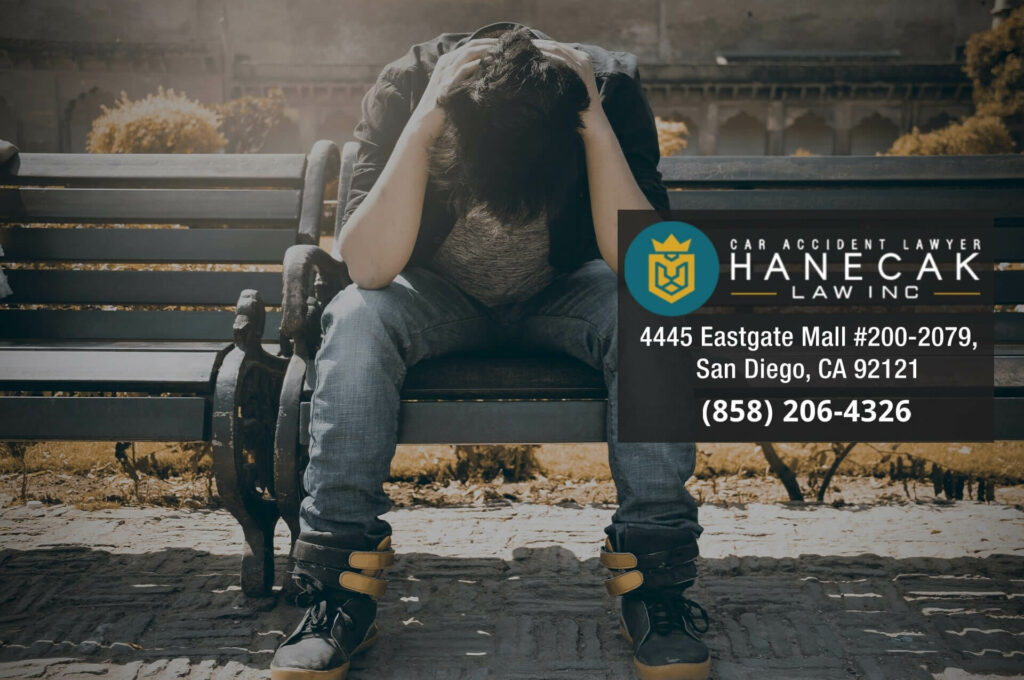Even small car accidents are emotionally distressing. For all the times we’re on the road, no one ever expects to get hit. When a car accident happens, our bodies will go into a “fight or flight” state to protect itself. This causes a flood of adrenaline through our bodies. The adrenaline can mask injuries and make many accident victims believe they aren’t injured. Sometimes injuries can take weeks or months to process because of our bodies trying to protect themselves.
But there is more to a car accident than physical injuries. There is the emotional aspect. Our daily lives are thrown into disarray. There are doctor’s appointments, expensive medical treatment, missed work, getting the car fixed. And if a settlement can’t be reached, then the stress of a lawsuit is added. All of these things can easily run a person down and cause extreme emotional distress and mental anguish.
When it comes to proving emotional distress, however, courts look at it in a very specific way. Unless there is intent to harm or extreme recklessness, emotional distress damages will be included as part of pain and suffering from the accident.
In California, there are two main types of emotional distress causes of action (a cause of action is the type of claim being made by the plaintiff). They are: 1) intentional infliction of emotional distress; and 2) negligent infliction of emotional distress.
What is Intentional Infliction of Emotional Distress?
Every cause of action has “elements” that must be proven in court. A plaintiff must prove every element for their claim to be successful. If they can’t prove every element, or the defendant is able to defend one of them, the claim will fail.
A plaintiff must meet the following elements to prove emotional distress:
- The defendant’s conduct was outrageous to a reasonable person;
- The defendant intended to cause harm; or acted with reckless disregard knowing the plaintiff would suffer emotional distress and the plaintiff was present;
- The plaintiff suffered severe emotional distress; and,
- The defendant’s conduct was a substantial factor in causing the emotional distress.
To be able to prove emotional distress, a plaintiff must show “intent” of the defendant. This means the defendant had to act in a way they knew would cause the plaintiff emotional distress. A car accident, is typically just that, an accident.
It’s certainly arguable that running a red light is outrageous or reckless. But to prove intentional emotional distress, the plaintiff must also prove they were physically present and the defendant intended for the consequences to happen. The standard to prove this is very high and typically doesn’t apply to car accidents. At-fault parties in car accidents don’t usually intend for them to happen. Or for the person they hit to suffer emotional distress. One example where intentional emotional distress would apply to a car accident is when the at-fault party was driving drunk.
What is Negligent Infliction of Emotional Distress?
Negligent Infliction of Emotional Distress is a little different than its intentional counterpart. When someone is injured in an accident, the claim they are making is for “Negligence.” So this may think where it ties in, but this claim really is more about someone other than the person injured. The claim is usually reserved for someone who has a close relationship with the victim and was at or near the scene when things happened. If they fulfill the following elements, they may be able to bring a claim for emotional distress subject to the following.
A claim for Negligent Infliction of Emotional Distress in California requires:
- The defendant negligently caused the injury/death of the plaintiff;
- Plaintiff was present at the scene of the injury and the victim was injured;
- Plaintiff suffered serious emotional distress;
- Defendant’s conduct was a substantial factor.
The main example of this type of claim could be where a family member witnesses another get seriously injured or die in a car accident. Because this is a traumatic event, the family member reasonably suffers enormous emotional distress as a result. Where the family member or closely related person was in the “zone of danger” or close proximity, they can seek damages for emotional distress. This essentially means that even if the bystander/family member wasn’t physically injured, they can recover for witnessing the accident.
How do I recover emotional distress after a car accident?
While the above emotional distress claims seem to be related to car accidents, any emotional distress damages are typically already considered before they’d arise. Emotional distress is included as part of “pain in suffering” in a negligence claim. Pain and suffering is an all-inclusive term that applies to both physical and mental trauma from a car accident.
It is supported by showing intensity of distress, duration of the pain, related bodily injury, underlying cause of pain, and a doctor’s note of your psychological symptoms. If the emotional distress is significant, it will likely require the diagnosis of a medical professional detailing how the car accident was the cause of it.
Emotional distress can be difficult to prove because it can be argued as subjective. A broken bone or scar is easily identifiable. What’s going on in someone’s mind at any given time or how their injuries have effected them is much harder to determine.
Finally, one last note about emotional distress, car accident claims, and litigation. While doctor’s appointments, the insurance company playing tricks, and litigation are all stressful, you can unfortunately not recover damages for emotional distress related to these. Especially the stress of litigation. This has been argued and defeated many times.
San Diego Car Accident Lawyer
My name is Daniel Hanecak and I am a San Diego Car Accident Lawyer. I know from personal experience how stressful and time consuming a car accident can be. When you call Hanecak Law Inc., you will speak with me directly. It is my aim to provide you with free and friendly advice. Call me today at (858) 206-4326 for a free case evaluation.
If you’d like to see what others say about me, please look at my profile pages on:














